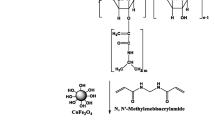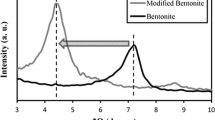Abstract
The objective of the present study was to synthesize Gg-cl-poly(NIPAm-co-AA)/-o-MWCNT (GNACNT) hydrogel via free radical copolymerization using the following ingredients: gum ghatti as biopolymer (GG), acrylic acid (AA) as a probe for synthetic monomer, ammonium persulphate as initiator, and methylene bis-acrylamide (MBA) as cross-linker. This hydrogel shows superior mechanical performance by incorporating filler such as oxidized multiwalled carbon nanotubes (-o-MWCNT) in varying quantities (0–50 mg) to produce polymer/inorganic composite hydrogels which has one of the most promising ways for improving the mechanical characteristics of hydrogels. In the linear viscoelastic region, the storage modulus (G′) was much higher than the loss modulus (G″) for all hydrogels across the entire frequency range. The persistent covalence crosslinking is responsible for the solid-like behaviour and elastic nature (G′ > G″). When additional -o-MWCNT was added, G′ was found to be increased. The -o-MWCNT’s interaction became stronger when the MWNT dispersion quality improved or their network connections, aspect ratio, or concentration rose, as shown by a greater storage modulus G, complex viscosity |η*|, and constant shear viscosity. Suspensions containing a combination of separated -o-MWCNT aggregates and small -o-MWCNT aggregates displayed G′ that was independent of frequency, indicating solid-like behaviour. As a result, these hydrogels may have potential uses in biological disciplines that are not limited by water capacity or mechanical qualities.











Similar content being viewed by others
Data availability
The authors declare that the data supporting the findings of this study are available within the paper and its Supplementary Information files.
References
T. W. and R. B. Zili Li, Miao Tang, Jingwen Dai, “Effect of multiwalled carbon nanotube-grafted polymer brushes on the mechanical and swelling properties of polyacrylamide composite hydrogels,” 2016, https://doi.org/10.1016/j.polymer.2016.01.025.This.
F. Xu et al., “Hydrogels for tissue engineering: addressing key design needs toward clinical translation,” Front. Bioeng. Biotechnol 10(May) (2022). https://doi.org/10.3389/fbioe.2022.849831.
S. Mantha et al., “Smart hydrogels in tissue engineering and regenerative medicine,” Materials (Basel)., 12(20) (2019). https://doi.org/10.3390/ma12203323.
M. Ruggeri et al., “Clay-based hydrogels as drug delivery vehicles of curcumin nanocrystals for topical application,” Pharmaceutics 14(12) (2022). https://doi.org/10.3390/pharmaceutics14122836.
P. N. Dave, P. M. Macwan, and B. Kamaliya, “Preparation and enhancing properties of pH-sensitive hydrogel in light of gum ghatti-cl-poly(acrylic acid)/ – o-MWCNT for sodium diclofenac drug release,” Macromolecular Chemistry and Physics 224(12) (2023). https://doi.org/10.1002/macp.202300038.
A. Ehrenhofer, S. Binder, G. Gerlach, and T. Wallmersperger, “Multisensitive Swelling of hydrogels for sensor and actuator design,” Adv. Eng. Mater 22(7) (2020). https://doi.org/10.1002/adem.202000004.
Franke, D., Gerlach, G.: Swelling studies of porous and nonporous semi-IPN hydrogels for sensor and actuator applications. Micromachines 11(4), 13–16 (2020). https://doi.org/10.3390/MI11040425
Luo, K., Yang, Y., Shao, Z.: Physically crosslinked biocompatible silk-fibroin-based hydrogels with high mechanical performance. Adv. Funct. Mater. 26(6), 872–880 (2016). https://doi.org/10.1002/adfm.201503450
Peak, C.W., Wilker, J.J., Schmidt, G.: A review on tough and sticky hydrogels. Colloid Polym. Sci. 291(9), 2031–2047 (2013). https://doi.org/10.1007/s00396-013-3021-y
Tan, Y., Xu, S., Wu, R., Du, J., Sang, J., Wang, J.: A gradient Laponite-crosslinked nanocomposite hydrogel with anisotropic stress and thermo-response. Appl. Clay Sci. 148(February), 77–82 (2017). https://doi.org/10.1016/j.clay.2017.08.004
Liu, X., et al.: A facile approach to obtain highly tough and stretchable LAPONITE®-based nanocomposite hydrogels. Soft Matter 16(36), 8394–8399 (2020). https://doi.org/10.1039/d0sm01132k
A. El-Refaey, Y. Ito, and M. Kawamoto, “Nanocomposite hydrogels containing few-layer graphene sheets prepared through noncovalent exfoliation show improved mechanical properties,”. Nanomaterials, 12 (18) (2022). https://doi.org/10.3390/nano12183129.
Dave, P.N., Macwan, P.M., Kamaliya, B.: Synthesis and rheological investigations of gum-ghatti-cl-poly(NIPA- co -AA)-graphene oxide based hydrogels. Mater. Adv. (2023). https://doi.org/10.1039/d3ma00092c
Bratovcic, A.: Nanocomposite hydrogels reinforced by carbon nanotubes. Int. J. Eng. Res. Appl. 10(5), 30–41 (2020). https://doi.org/10.9790/9622-1005043041
ArtiVashist, M.N., Kaushik, A., Vashist, A., Sagar, V., AnujitGhosal, Y.K., Gupta, S.A.: Advances in carbon nanotubes - hydrogel hybrids in nanomedicine for therapeutics. Physiol. Behav 176(1), 139–148 (2017). https://doi.org/10.1002/adhm.201701213
Mittal, H., Mishra, S.B., Mishra, A.K., Kaith, B.S., Jindal, R.: Flocculation characteristics and biodegradation studies of gum ghatti based hydrogels. Int. J. Biol. Macromol. 58, 37–46 (2013). https://doi.org/10.1016/j.ijbiomac.2013.03.045
Toto, E., Santonicola, M.G., Ciarleglio, G.: “Conductive and thermo-responsive composite hydrogels with poly(N-isopropylacrylamide) and carbon nanotubes fabricated by two-step photopolymerization”. Polymers. 15(4), 1022 (2023).
Jyoti, J., Singh, B.P., Rajput, S., Singh, V.N., Dhakate, S.R.: Detailed dynamic rheological studies of multiwall carbon nanotube-reinforced acrylonitrile butadiene styrene composite. J. Mater. Sci. 51(5), 2643–2652 (2016). https://doi.org/10.1007/s10853-015-9578-8
Kanagaraj, S., Guedes, R.M., Oliveira, M.S.A., Simões, J.A.O.: Dynamic mechanical analysis of multi-walled carbon nanotube/HDPE composites. J. Nanosci. Nanotechnol. 8(8), 4008–4012 (2008). https://doi.org/10.1166/jnn.2008.AN53
Shen, Z., Roding, M., Kroger, M., Li, Y.: Carbon nanotube length governs the viscoelasticity and permeability of buckypaper. Polymers (Basel) 9(4), 1–18 (2017). https://doi.org/10.3390/polym9040115
Fan, Z., Advani, S.G.: Rheology of multiwall carbon nanotube suspensions. J. Rheol (N.Y.N.Y) 51(4), 585–604 (2007). https://doi.org/10.1122/1.2736424
Sathaye, S., et al.: Rheology of peptide- and protein-based physical hydrogels: are everyday measurements just scratching the surface? Wiley Interdiscip. Rev. Nanomedicine Nanobiotechnology 7(1), 34–68 (2015). https://doi.org/10.1002/wnan.1299
Yan, C., Pochan, D.J.: Rheological properties of peptide-based hydrogels for biomedical and other applications. Bone 39(9), 1–7 (2010). https://doi.org/10.1039/b919449p
Hao, Z.Q., Chen, Z.J., Chang, M.C., Meng, J.L., Liu, J.Y., Feng, C.P.: Rheological properties and gel characteristics of polysaccharides from fruit-bodies of sparassis crispa. Int. J. Food Prop. 21(1), 2283–2295 (2018). https://doi.org/10.1080/10942912.2018.1510838
Zuidema, J.M., Rivet, C.J., Gilbert, R.J., Morrison, F.A.: A protocol for rheological characterization of hydrogels for tissue engineering strategies. J. Biomed. Mater. Res.- Part B Appl. Biomater. 102(5), 1063–1073 (2014). https://doi.org/10.1002/jbm.b.33088
Tafete, G.A., Thothadri, G., Abera, M.K.: A review on carbon nanotube-based composites for electrocatalyst applications. Fullerenes Nanotub. Carbon Nanostructures 30(11), 1075–1083 (2022). https://doi.org/10.1080/1536383X.2022.2028278
Seman, R.N.A.R., Azam, M.A., Mohamad, A.A.: Systematic gap analysis of carbon nanotube-based lithium-ion batteries and electrochemical capacitors. Renew. Sustain. Energy Rev. 75(July), 644–659 (2017). https://doi.org/10.1016/j.rser.2016.10.078
Tong, X., Zheng, J., Lu, Y., Zhang, Z., Cheng, H.: Swelling and mechanical behaviors of carbon nanotube/poly(vinyl alcohol) hybrid hydrogels. Mater. Lett. 61(8), 1704–1706 (2007). https://doi.org/10.1016/j.matlet.2006.07.115
Bhattacharyya, S., Guillot, S., Dabboue, H., Tranchant, J.F., Salvetat, J.P.: Carbon nanotubes as structural nanofibers for hyaluronic acid hydrogel scaffolds. Biomacromol 9(2), 505–509 (2008). https://doi.org/10.1021/bm7009976
Liu, H., Liu, M., Zhang, L., Ma, L., Chen, J., Wang, Y.: Dual-stimuli sensitive composites based on multi-walled carbon nanotubes and poly(N, N-diethylacrylamide-co-acrylic acid) hydrogels. React. Funct. Polym. 70(5), 294–300 (2010). https://doi.org/10.1016/j.reactfunctpolym.2010.02.002
Barkoula, N.M., Alcock, B., Cabrera, N.O., Peijs, T.: Flame-retardancy properties of intumescent ammonium poly(phosphate) and mineral filler magnesium hydroxide in combination with graphene. Polym. Polym. Compos. 16(2), 101–113 (2008). (10.1002/pc)
R. B. Zili Li, Miao Tang, Jingwen Dai, Taisheng Wang, “Effect of multiwalled carbon nanotube-grafted polymer brushes on the mechanical and,” JPOL, (2016). https://doi.org/10.1016/j.polymer.2016.01.025.
Kamaliya, B., Dave, P.N., Macwan, P.M.: Oxidized multiwalled carbon nanotube reinforced rheological examination on gum ghatti-cl-poly(acrylic acid) hydrogels. J. Appl. Polym. Sci. 139(43), 1–16 (2022). https://doi.org/10.1002/app.52888
A. Verma, P. Kumar, V. Rastogi, and P. Mittal, “Preparation and evaluation of polymeric beads composed of Chitosan–Gellan Gum–Gum Ghatti/-Gum Karaya polyelectrolyte complexes as polymeric carrier for enteric sustained delivery of Diclofenac sodium,” Futur. J. Pharm. Sci. 7(1) (2021). https://doi.org/10.1186/s43094-021-00343-y.
Del Giudice, F., Shen, A.Q.: Shear rheology of graphene oxide dispersions. Curr. Opin. Chem. Eng. 16, 23–30 (2017). https://doi.org/10.1016/j.coche.2017.04.003
A. Shukla, A. P. Singh, and P. Maiti, “Injectable hydrogels of newly designed brush biopolymers as sustained drug-delivery vehicle for melanoma treatment,” Signal Transduct. Target. Ther 6(1) (2021). https://doi.org/10.1038/s41392-020-00431-0.
Chang, Q., et al.: Hydrogels from natural egg white with extraordinary stretchability, direct-writing 3D printability and self-healing for fabrication of electronic sensors and actuators. J. Mater. Chem. A 7(42), 24626–24640 (2019). https://doi.org/10.1039/c9ta06233e
Dave, P.N., Macwan, P.M., Kamaliya, B.: “Synthesis and characterization of biodegradable gum ghatti- cl - poly ( AA- co -NIPAm )/ GO based hydrogel for metformin and sodium diclofenac combined drug delivery system”, Colloids Surfaces A Physicochem. Eng. Asp. J. 673(May), 131815–131826 (2023). https://doi.org/10.1016/j.colsurfa.2023.131815
I. A. Podaru et al., “Poly(N-vinylpyrrolidone)–Laponite XLG nanocomposite hydrogels: characterization, properties and comparison with divinyl monomer-crosslinked hydrogels,” Polymers (Basel) 14919) (2022). https://doi.org/10.3390/polym14194216.
Abbastabar, B., Azizi, M.H., Adnani, A., Abbasi, S.: Determining and modeling rheological characteristics of quince seed gum. Food Hydrocoll. 43, 259–264 (2015). https://doi.org/10.1016/j.foodhyd.2014.05.026
Cross, M.M.: Rheology of non-newtonian fluids: a new flow equation for pseudoplastic systems. J. Colloid Sci. 20, 417–437 (1965).
Benchabane, A., Bekkour, K.: Rheological properties of carboxymethyl cellulose (CMC) solutions. Colloid Polym. Sci. 286(10), 1173–1180 (2008). https://doi.org/10.1007/s00396-008-1882-2
Dunstan, D.E., Hill, E.K., Wei, Y.: Direct measurement of polymer segment orientation and distortion in shear: semi-dilute solution behavior. Polymer (Guildf) 45(4), 1261–1266 (2004). https://doi.org/10.1016/j.polymer.2003.12.018
Clasen, C., Kulicke, W.M.: Determination of viscoelastic and rheo-optical material functions of water-soluble cellulose derivatives. Prog. Polym. Sci. 26(9), 1839–1919 (2001). https://doi.org/10.1016/S0079-6700(01)00024-7
Álvarez, E., Cancela, M.A., Delgado-Bastidas, N., MacEiras, R.: Rheological characterization of commercial baby fruit purees. Int. J. Food Prop. 11(2), 321–329 (2008). https://doi.org/10.1080/10942910701359424
Ali, L., Tanzil, S., Rehman, U., Khan, M.: Synthesis of graphene oxide doped thixotropic behavior. Polym. Bull. 0123456789, 3921–3935 (2019)
Baloochestanzadeh, S., Hassanajili, S., Escrochi, M.: Rheological properties and swelling behavior of nanocomposite preformed particle gels based on starch-graft-polyacrylamide loaded with nanosilica. Rheol. Acta 60(10), 571–585 (2021). https://doi.org/10.1007/s00397-021-01287-z
Kotsilkova, R., Tabakova, S., Ivanova, R.: Effect of graphene nanoplatelets and multiwalled carbon nanotubes on the viscous and viscoelastic properties and printability of polylactide nanocomposites. Mech. Time-Dependent Mater. 26(3), 611–632 (2022). https://doi.org/10.1007/s11043-021-09503-2
Li, G., Zhang, H., Fortin, D., Xia, H., Zhao, Y.: Poly(vinyl alcohol)-poly(ethylene glycol) double-network hydrogel: a general approach to shape memory and self-healing functionalities. Langmuir 31(42), 11709–11716 (2015). https://doi.org/10.1021/acs.langmuir.5b03474
Yang, Z., Peng, H., Wang, W., Liu, T.: Crystallization behavior of poly(ε-caprolactone)/layered double hydroxide nanocomposites. J. Appl. Polym. Sci. 116(5), 2658–2667 (2010). https://doi.org/10.1002/app
Guan, Y., et al.: Preparation and rheological investigation of tough PAAm hydrogel by adding branched polyethyleneimine. J. Appl. Polym. Sci. 137(14), 1–7 (2020). https://doi.org/10.1002/app.48541
Yetgin, S.H.: Effect of multi walled carbon nanotube on mechanical, thermal and rheological properties of polypropylene. J. Mater. Res. Technol. 8(5), 4725–4735 (2019). https://doi.org/10.1016/j.jmrt.2019.08.018
Silva, S.S., et al.: The use of ionic liquids in the processing of chitosan/silk hydrogels for biomedical applications. Green Chem. 14(5), 1463–1470 (2012). https://doi.org/10.1039/c2gc16535j
Zhang, X., Pan, Z.: Rheological behavior of regenerated silk fibroin/polyvinyl alcohol blended solutions in steady and dynamic state and the effect of temperature. J. Mater. Sci. 55(31), 15350–15363 (2020). https://doi.org/10.1007/s10853-020-05086-4
Razi, S.M., Motamedzadegan, A., Shahidi, S.A., Rashidinejad, A.: Steady and dynamic shear rheology as a toolfor evaluation of the interactions between egg white albumin and basil seed gum. Rheol. Acta 59(5), 317–331 (2020). https://doi.org/10.1007/s00397-020-01198-5
G. Stojkov, Z. Niyazov, F. Picchioni, and R. K. Bose, “Relationship between structure and rheology of hydrogels for various applications,” Gels. 7(4) (2021). https://doi.org/10.3390/gels7040255.
M. A. Marcos et al., “Influence of molecular mass of PEG on rheological behaviour of MWCNT-based nanofluids for thermal energy storage,” J. Mol. Liq. 318 (2020). https://doi.org/10.1016/j.molliq.2020.113965.
Moniruzzaman, M., Sahin, A., Winey, K.I.: Improved mechanical strength and electrical conductivity of organogels containing carbon nanotubes. Carbon N. Y. 47(3), 645–650 (2009). https://doi.org/10.1016/j.carbon.2008.10.046
Acknowledgements
One of the authors BK is thankful for the Shodh fellowship provided by the Government of Gujarat and to the Department of Chemistry for the laboratory facility and Instrumental facilities for various analyses at Sardar Patel University, V. V. Nagar and CISST Department for characterization of the samples.
Author information
Authors and Affiliations
Contributions
Pragnesh N Dave: conceptualization; project administration; resources; software; supervision; validation; visualization; writing—review and editing.
Pradip M. Macwan: visualization; roles/writing—original draft.
Bhagvan Kamaliya: data curation; formal analysis; investigation; project.
Corresponding author
Ethics declarations
Conflict of interest
The authors declare no competing interests.
Additional information
Publisher's Note
Springer Nature remains neutral with regard to jurisdictional claims in published maps and institutional affiliations.
Supplementary Information
Below is the link to the electronic supplementary material.
Rights and permissions
Springer Nature or its licensor (e.g. a society or other partner) holds exclusive rights to this article under a publishing agreement with the author(s) or other rightsholder(s); author self-archiving of the accepted manuscript version of this article is solely governed by the terms of such publishing agreement and applicable law.
About this article
Cite this article
Dave, P.N., Macwan, P.M. & Kamaliya, B. Reinforcing effect of oxidized multiwalled carbon nanotubes on swelling and mechanical properties of gum ghatti-cl-poly(NIPAm-co-AA) hydrogels. Mech Soft Mater 6, 2 (2024). https://doi.org/10.1007/s42558-024-00057-0
Received:
Accepted:
Published:
DOI: https://doi.org/10.1007/s42558-024-00057-0




